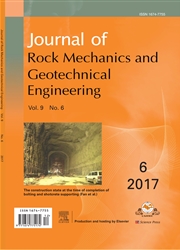

 中文摘要:
中文摘要:
This study uses a three-dimensional crack model to theoretically derive the Hoeke Brown rock failure criterion based on the linear elastic fracture theory. Specifically, we argue that a failure characteristic factor needs to exceed a critical value when macro-failure occurs. This factor is a product of the microfailure orientation angle(characterizing the density and orientation of damaged micro-cracks) and the changing rate of the angle with respect to the major principal stress(characterizing the microscopic stability of damaged cracks). We further demonstrate that the factor mathematically leads to the empirical Hoeke Brown rock failure criterion. Thus, the proposed factor is able to successfully relate the evolution of microscopic damaged crack characteristics to macro-failure. Based on this theoretical development, we also propose a quantitative relationship between the brittleeductile transition point and confining pressure, which is consistent with experimental observations.
 英文摘要:
英文摘要:
This study uses a three-dimensional crack model to theoretically derive the HoekeBrown rock failure criterion based on the linear elastic fracture theory. Specifically, we argue that a failure characteristic factor needs to exceed a critical value when macro-failure occurs. This factor is a product of the micro-failure orientation angle (characterizing the density and orientation of damaged micro-cracks) and the changing rate of the angle with respect to the major principal stress (characterizing the microscopic stability of damaged cracks). We further demonstrate that the factor mathematically leads to the empirical HoekeBrown rock failure criterion. Thus, the proposed factor is able to successfully relate the evolution of microscopic damaged crack characteristics to macro-failure. Based on this theoretical development, we also propose a quantitative relationship between the brittleeductile transition point and confining pressure, which is consistent with experimental observations.
 同期刊论文项目
同期刊论文项目
 同项目期刊论文
同项目期刊论文
 期刊信息
期刊信息
